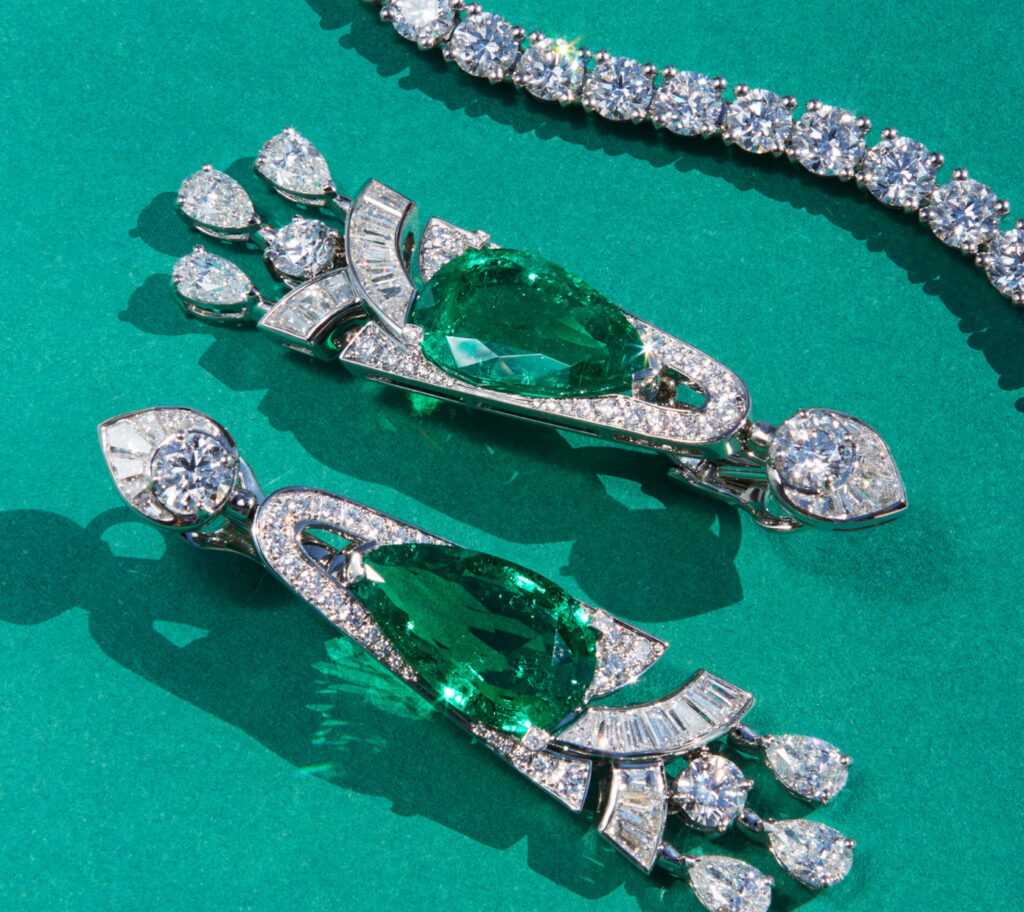In the rarefied atmosphere of haute joaillerie, where matter transforms into myth and minerals become symbols of civilizational ambition, Bvlgari’s High Jewellery creations stand not merely as ornaments but as testaments to a distinct philosophical approach to adornment. With the unveiling of a spectacular necklace and matching earrings—both wrought in platinum and encrusted with an orchestra of emeralds and diamonds—Bvlgari continues its legacy of opulence as a language, not just a style.
These two pieces—one architectural and imperial, the other intimate and gravitational—are sculptural expressions of control over the uncontrollable: light, desire, and the mystique of the emerald, a stone revered since antiquity for its depth, clarity, and the alchemy of its green flame.
The Emerald as Oracle: Historical Weight, Contemporary Voltage
To understand the impact of these Bvlgari creations, one must first understand the cultural and historical charge of the emerald. From the ancient Egyptian mines of Cleopatra’s reign to Mughal thrones, the emerald has long signified sovereignty, clarity of mind, and the unseen forces of the earth. It is not a passive gem—it demands to be seen and interpreted.
Bvlgari has long understood this. Unlike other houses that tame emeralds into delicate flourishes, Bvlgari positions them as protagonists. This necklace, centered on a staggering 241.04ct emerald-cut emerald, is not simply set—it is enthroned. Surrounding it is a constellation of 51 round diamonds (35.14ct), 3 square step diamonds (3.21ct), 1 cabochon emerald (2.27ct), 111 step-cut diamonds (28.20ct), and 76 buff-top emeralds (10.31ct). These are not embellishments; they are a court in attendance.
The earrings echo this central drama. With two pear emeralds (8.65ct and 7.99ct) flanked by 4 round diamonds, 6 pear-shaped diamonds, 34 step-cut diamonds, and a lattice of pavé-set brilliance, they radiate in miniature what the necklace asserts on a monumental scale.
Platinum as Medium: Eternity with an Edge
There is an implicit logic to Bvlgari’s choice of platinum. It is not simply a metal; it is a timekeeper—resistant to age, capable of retaining polish for centuries, rarer than gold, and impervious to fashion’s decay. Platinum carries with it the scent of permanence. When set against the incandescent green of Colombian emeralds or the high-lucidity diamonds chosen here, it becomes a canvas of eternity.
But Bvlgari doesn’t just use platinum as a structural support. It is integrated into the narrative logic of the piece. In both necklace and earrings, platinum acts like the negative space in painting: shaping what we perceive by what it does not say. It provides weight without mass, a regal inertia that slows time down around the emerald’s burning axis.
Geometry of Awe: Cut, Calibration, and Spatial Discipline
If jewellery is architecture in miniature, then these Bvlgari pieces are cathedrals. The emerald-cut is a deliberate invocation of symmetry, discipline, and strength. Unlike brilliant or cushion cuts, the emerald cut does not hide inclusions; it reveals them. Its long facets invite the eye to journey into the depths of the stone, an invitation to immerse, not merely admire.
The presence of step-cut diamonds reinforces this philosophy. They draw the gaze outward, from the focal emerald and into the periphery of light. They are not there to distract but to orchestrate. Every stone is placed, not positioned—an important distinction. Round diamonds soften the rigidity of the structure, while the buff-top emeralds—rare for their sculptural domes and absence of facet—add texture and relief, like notes in a musical score played sotto voce beneath a crescendo.
Italian Bloodline: Roman Maximalism Refined
Bvlgari’s aesthetic is unapologetically Roman: maximalist, sensual, and carved from centuries of visual excess. But within this apparent grandeur lies a rigorous discipline. The necklace and earrings, while abundant in carat and detail, are balanced like temple friezes—never teetering into vulgarity or overstatement.
This is no accident. Bvlgari’s High Jewellery atelier follows a lineage that traces back to Greek silversmithing, Etruscan granulation, and Baroque ecclesiastical ornamentation. What emerges is not fusion, but evolution. The brand’s signature approach to color, volume, and structure is not about ornamentation for its own sake—it is about amplifying the essential. The emerald is the epicenter; everything else revolves around it with cosmic precision.
The Dialogue of Elements: Emerald and Diamond
There is a dialogue—sometimes a duel—between emerald and diamond. Where emerald is mysterious, diamond is declarative. Where emerald absorbs, diamond reflects. In Bvlgari’s execution, they do not compete; they perform a visual fugue. The necklace’s 241ct emerald anchors the composition like a keystone, while the diamonds dance around it, translating its green interiority into flashes of pure spectral light.
In the earrings, the balance is even more precise. The pear-shaped emeralds, evocative of tears or leaves or fire, act as emotional punctuation. The diamond surrounds provide lift and shimmer, turning every motion of the wearer’s head into a miniature spectacle of refraction and rhythm.
Wearability and Theatrics: Function in Opulence
It would be a mistake to assume that these pieces are solely for static display. Though their provenance and scale suggest museum-grade artifacts, they are engineered for motion. The platinum chains of the necklace are articulated to flex across collarbones without torque or pinch. The earrings are weighted to pivot slightly, allowing for dynamism without drag.
This wearability—often under-discussed in jewellery editorial—is crucial. These pieces are not costume; they are instruments, calibrated to the human form. Whether worn at a gala, a sovereign ceremony, or behind private palace doors, they amplify not only the light of the room but the presence of the wearer.
Symbolism and Rarity: Beyond Material Value
Let us consider the rarity of the central stone. A 241.04ct emerald of such clarity and symmetry is virtually without peer. The likelihood of a comparable gem being unearthed, unfractured, and cut without catastrophic loss is infinitesimal. Its presence elevates this necklace into the realm of singularity. It is not an accessory; it is a historical event.
Each element compounds this symbolism. The cabochon emerald, though diminutive by comparison, nods to ancient styles. The buff-top emeralds evoke mid-century modernism. The mix of cuts—round, pear, step, and buff—spans millennia of gemological philosophy. The result is a piece that does not merely reference history, but seems to contain it.
The Art Collector’s Dilemma: Jewellery as Masterwork
For collectors, pieces like these force a difficult question: are they to be worn, or preserved? Unlike paintings, high jewellery is meant to interact with the world. Yet the scale, quality, and uniqueness of these Bvlgari creations place them closer to the domain of fine art than personal ornament.
Auction houses increasingly treat such works as museum-grade acquisitions. Private collectors, royal families, and art foundations bid not just for beauty, but for legacy. The line between the art market and the jewellery market has never been blurrier. With works like these, Bvlgari isn’t merely designing jewellery—it is shaping cultural heritage.
Light, Captured and Set Free
To encounter these Bvlgari High Jewellery creations is to witness not just craftsmanship, but cosmology. The necklace, anchored by a 241ct emerald that seems less mined than conjured, is a meditation on gravity. The earrings, flickering at the edge of perception, are distillations of dance. Together, they form a duet between earth and sky, mineral and motion.
In a world of fleeting design, fast luxury, and algorithmic aesthetics, Bvlgari offers something else entirely: time made visible. These pieces do not chase trends. They remind us that the ancient hunger for light, beauty, and power can still be satisfied—when approached with discipline, reverence, and radical imagination.
To wear them is to wield a fragment of the sublime. To see them is to know that jewellery, at its highest expression, does not decorate—it declares.
No comments yet.








